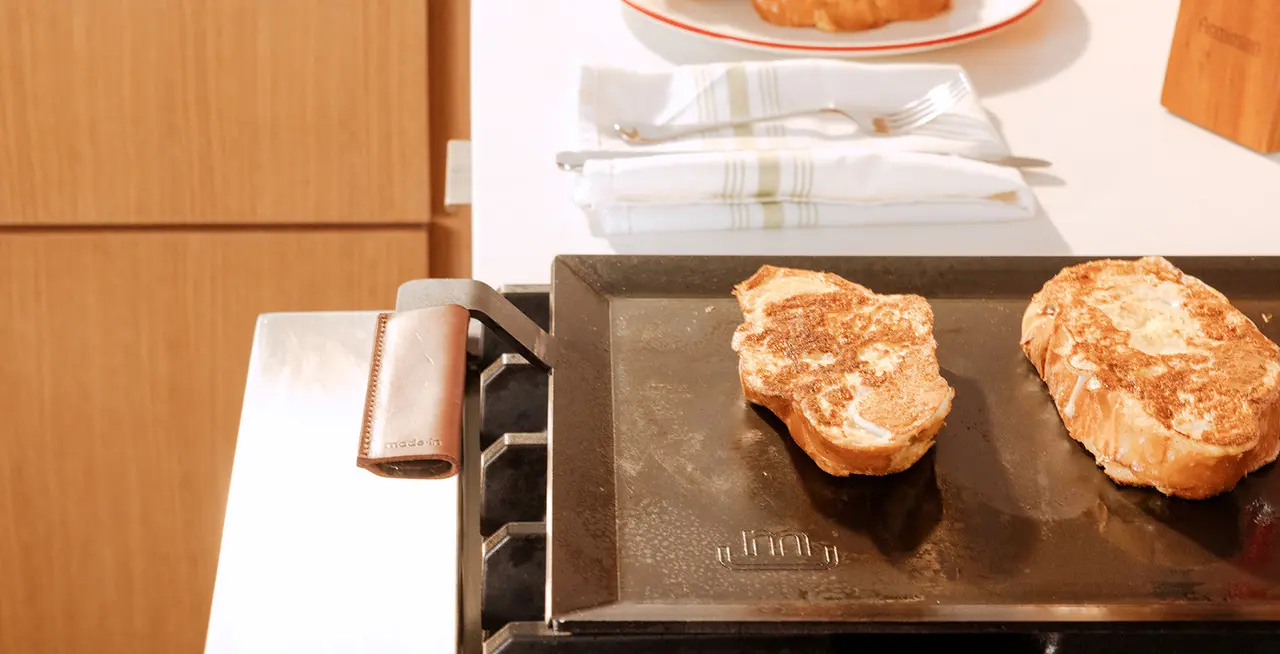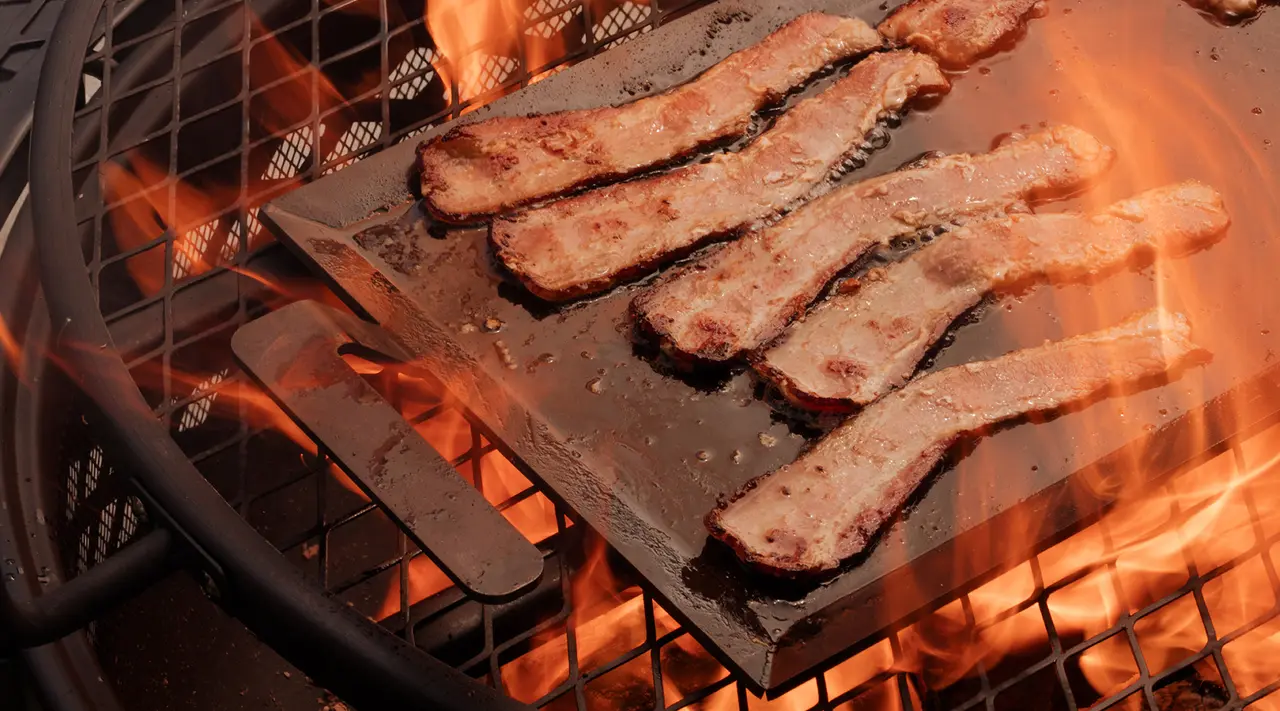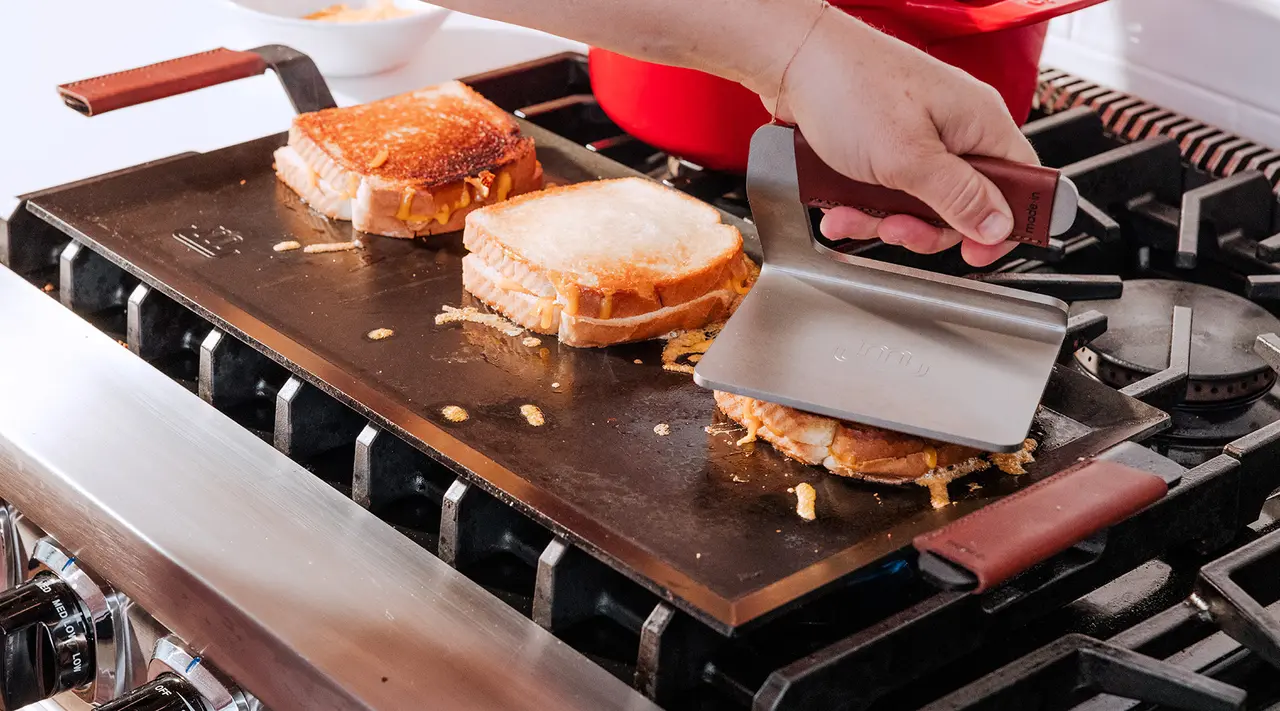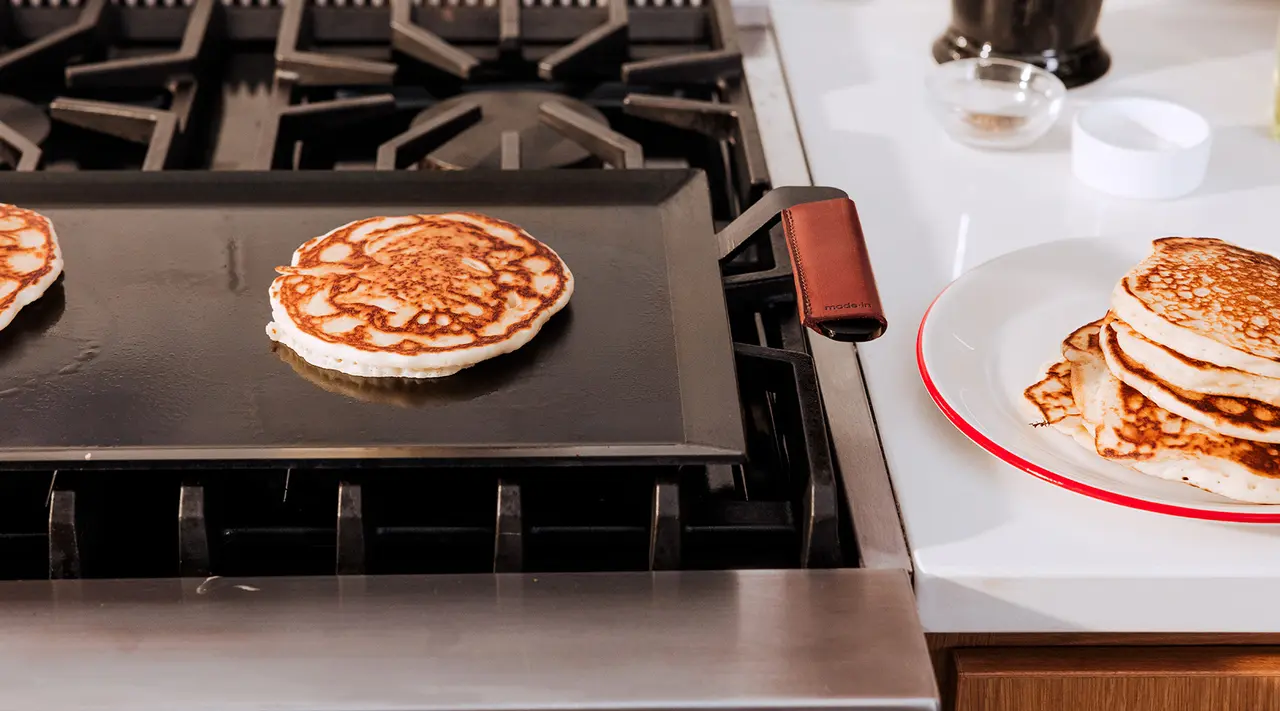Imagine your favorite skillet—whether cast iron, carbon steel, or non stick—but with several times the surface area. That’s what you get from a griddle. Because of its ample surface area, a griddle is the perfect tool for diner food aficionados or for just about anyone looking to cook a whole lot of food at once.
Not all home griddles are the same, however. In addition to size, griddles vary significantly in terms of material, design, and whether or not they can be used to cook directly on your stovetop or outdoor grill. Here’s our guide to choosing your next favorite kitchen tool.
Different Types of Griddles

Griddles available for home use come in two basic varieties: stovetop and electric. You can, of course, also find outdoor gas griddles, which come with their own stands and hook up to a gas tank like a regular grill—though these are basically a category in and of themselves, and one we won’t be touching on in this guide.
Stovetop Griddles
Stovetop griddles are the perfect no-fuss option for your gas or electric stove setup. Since they don’t need to be plugged in and fit right on top of your stove without taking up extra counter space, stovetop griddles make for a convenient and space-saving alternative to electric griddles Plus, you can place them directly over the grates of your outdoor grill, or use as part of a campfire or outdoor cooking setup.
Before you purchase a stovetop griddle, however, first make sure it’s compatible with your stovetop. Depending on the griddle’s design, you may not be able to cook with it on an induction stove—that said, if the griddle sits flush with your stovetop and/or is made of a ferromagnetic material, it’s likely fine to use with induction.
Electric Griddles
Electric griddles are exactly what they sound like: Rather than sitting on top of your stovetop, they contain their own heating element, which means that you’ll need to plug them into an outlet in order to use them. This can be beneficial for a variety of reasons: First, it frees up stove space, allowing you to cook, for example, a pot of rice and beans while you fry up crispy, cheesy quesatacos. Second, it can basically sub in for a stove if you don’t have a fully-equipped kitchen, or are cooking outside.
It’s important to note, however, that an electric stove requires a considerable amount of counter space, as well as an accessible outlet.
Griddle Size and Cooking Area

One of the most important factors to consider when shopping for a home griddle is size. You’ll notice that many griddle manufacturers list two sets of dimensions: the overall size (i.e. how much space it’ll take up) and then a cooking surface area. Griddles also typically feature a raised lip for trapping meat juices and other liquids, so the surface area will usually be an inch or two smaller than the overall size.
We highly recommend measuring your stove or counter space before making a decision, as this will prevent you from winding up with a griddle that overhangs your counter or stove top which can make for a cumbersome (and potentially dangerous) cooking experience. While our carbon steel griddle measures 24 by 10.5 inches, for example, you can also find griddles that measure as much as 30 by 14 inches—or opt for a single-burner option.
Cooking Surface Material

Griddles are most commonly made out of carbon steel, cast iron, and non stick-coated aluminum. Here’s how they differ based on price point, maintenance, and performance.
Carbon Steel
Lightweight, responsive, and with excellent heat retention, carbon steel is one of our favorite materials to cook with, especially in griddle form. We use it whenever we want any variety of dishes, whether that’s fish that’s lightly charred on the outside but flaky and tender within, oozy grilled cheese, or perfect smash burgers. With the increased surface area of a griddle, you can cook way more in fewer batches. Plus, carbon steel griddles feature a non stick surface thanks to built-up layers of seasoning.
If you do decide to go for a carbon steel griddle, note that carbon steel comes with a unique set of cleaning and maintenance requirements. You’ll need to hand wash your griddle after every use, and thoroughly wipe it dry before storing. It may also require an initial seasoning, as well—unless you choose a preseasoned option.
Cast Iron
Cast iron is excellent for getting a hard, even sear on meats, fish, and veggies, and for getting—and staying—ripping hot. This is a major plus when cooking on a griddle, as the stellar heat retention makes it so that you can cook a ton of food at the same time while maintaining a consistent surface temperature. And while cast iron tends to be heavier and less responsive than carbon steel, it’s a familiar option for those used to cooking with cast iron.
Maintaining a cast iron griddle is similar to maintaining carbon steel: In addition to cleaning and drying after every use, you’ll also want to keep it nicely seasoned (and therefore naturally non stick). Do note, however, that the process for seasoning cast iron is slightly different than for seasoning carbon steel.
Non Stick
Just like a go-to non stick frying pan, a non stick griddle is a versatile, relatively low-maintenance option for cooking everything from eggs to whole fish. This is particularly excellent news for breakfast enthusiasts. Imagine cranking out a buffet’s worth of pancakes, sausages, and omelets with only minimal cleanup required.
As with a non stick frying pan, however, you’ll need to be careful not to scratch up the surface of your non stick griddle. That means metal tools—such as metal scrapers, spatulas, or tongs—are strictly off-limits. You’ll also need to handwash your non stick griddle, as the dishwasher can cause permanent damage to both the coating and the metal base.
Heat Distribution and Evenness

For a griddle with excellent heat distribution, your best bet is probably going to be a carbon steel model. Carbon steel retains heat just as well as cast iron, but distributes it more evenly, so you can avoid overly hot or cold spots. If you decide to go for a non stick griddle, look for one with a heavy gauge aluminum or stainless clad base.
If you’re looking at stovetop griddles over electric griddles, you’ll almost definitely want one that can fit over two burners. This not only gives you more cooking surface area, but it also allows for dual zone cooking—i.e. setting up two different temperature zones. This is ideal for foods that require searing, like meat and fish.
Additional Features and Accessories

Another area to consider when choosing a griddle is whether it includes any specialized accessories. You may, for example, prefer a griddle that has a removable grease cup or drip tray attached, both of which collect grease, juice, and other drippings so that they don’t pool up while you cook. For keeping food warm while you finish cooking the rest of your meal, you can also buy warming racks that hook onto the sides of your griddle.
Along with accessories, you should also consider whether or not you want your griddle to be portable or not. While many griddles designed for at-home use (like our Carbon Steel Griddle) are technically portable, some may be too bulky or cumbersome to transport or store—to combat this, check to see if a griddle has handles, or is at least lightweight enough to carry. You can also find options that can be folded or disassembled for easier storage.
Cleaning and Maintenance

A griddle does not have to be high maintenance. We repeat: a griddle does not have to be high maintenance. That being said, all that extra surface area can make them a little more time-consuming to clean. If you absolutely hate the idea of scrubbing burnt food and oil off your griddle, you’re probably better off with a coated non stick. However, we strongly recommend picking up a carbon steel griddle: not only do they get (and stay) much hotter, but they’re also naturally non stick—at least once they’ve been seasoned properly.
No matter which griddle you choose, however, make sure you know how to properly clean and maintain it. Like we mentioned earlier, you should never put your griddle in the dishwasher—even if the manufacturer says it’s okay. It’s equally important to make sure that your carbon steel or cast iron griddle is properly seasoned before use, and taking care to reseason whenever it starts to feel sticky.
Safety Considerations

Much like any method that involves high heat cooking, if you’re using a carbon steel or cast iron griddle, you’ll want to have a solid ventilation system—like an overhead vent—to keep your kitchen from getting too smoky.
Electric griddles also often have safety features such as a light indicator, which either stays lit while the griddle is on, or turns off when it’s done preheating. It’s also a good idea to look for a griddle with sloped sides or high walls—no one wants hot grease dripping on their feet.
Budget and Value

While electric and stovetop griddles tend to be a bit more budget-friendly than gas griddles, they do come at a range of different price points. When making your decision, consider how often you plan to use your griddle. Are you more of a once-a-month pancake breakfast family? You can probably stick to a more affordable model. If you’re a more ambitious cook, however, we’d definitely recommend a high-quality carbon steel griddle.
Ready to Shop?
A griddle can be a fun and versatile addition to your cookware arsenal. Not only does it feel incredibly cool to use, but it can also offer a host of new opportunities for entertaining. Want to fire up, say, ten smash burgers at once, along with buns? Totally possible with a griddle.
Even if you’re not using it on the regular, however, a quality, long-lasting griddle is totally worth the investment. With its cast iron construction and welded handles, our carbon steel griddle is a worthy match for your home cooking skills.




























